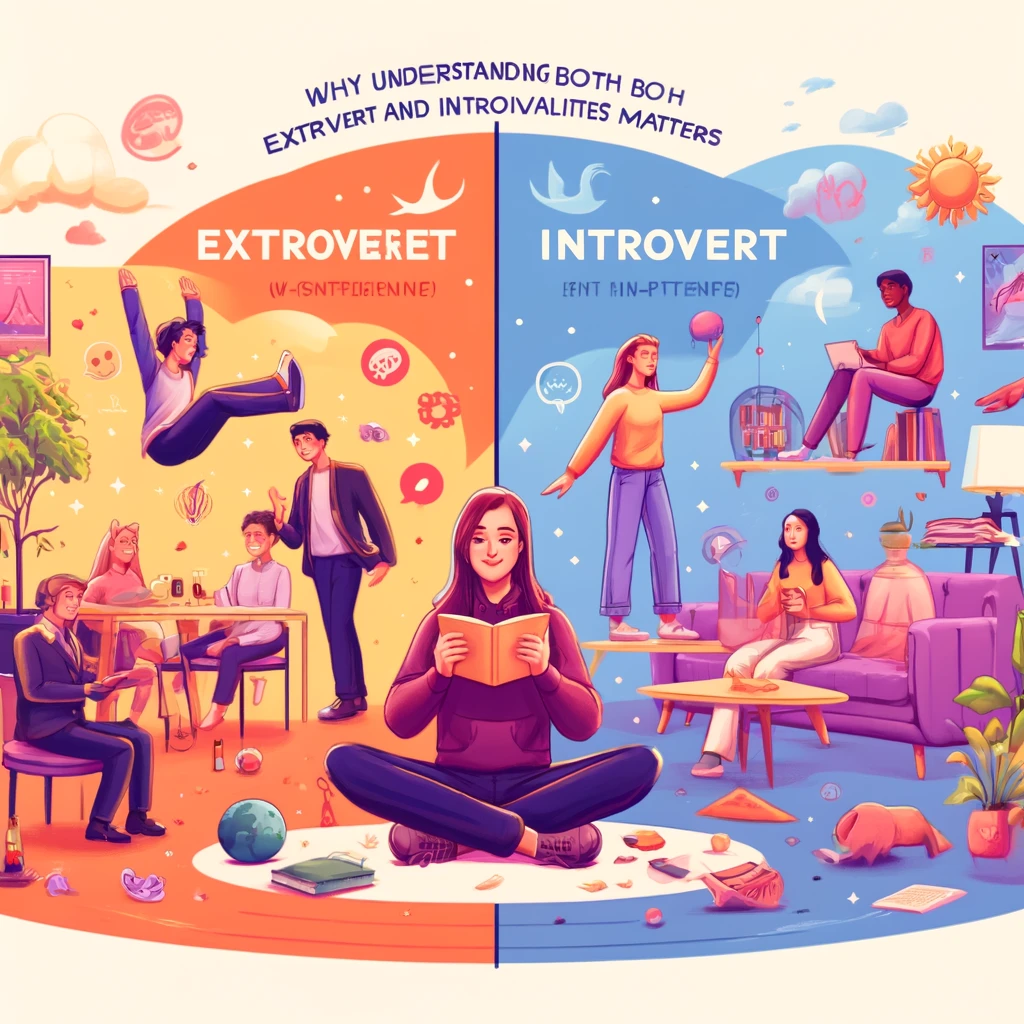Personality traits significantly influence how we interact with others, approach challenges, and experience life. Among the most studied and recognized traits are extroversion and introversion, which describe where individuals primarily draw their energy from—social interaction or solitude. Understanding these traits helps us appreciate the diversity in people’s behaviors and preferences. This article will delve into both extrovert and introvert personalities, examining their characteristics, strengths, and challenges. By understanding these traits, we can foster better relationships and create more harmonious environments. You can also read this What is Örviti: A Detailed Guide
What is an Extrovert?
Extroverts are often characterized by their outgoing, energetic, and sociable nature. These individuals thrive in social settings, drawing energy from interacting with others. Extroverts enjoy being the center of attention and are often seen as lively and enthusiastic.
Extroverts are known for their sociability, often seeking out and enjoying social interactions. They feel energized by spending time with others and are typically very expressive, readily communicating their thoughts and feelings. Their enthusiasm and dynamism make them engaging company, and they often bring a lot of energy to group activities.
Assertiveness is another key trait of extroverts. They are usually confident in their opinions and comfortable taking the lead in conversations and projects. This confidence often makes them effective leaders, as they are not afraid to take charge and make decisions.
In professional and personal settings, extroverts bring many strengths. Their sociable nature helps them build extensive networks and form connections quickly. In teamwork scenarios, they contribute significantly by bringing energy and facilitating group discussions. Their assertiveness and enthusiasm often lead them to leadership roles where clear and frequent communication is essential.
However, extroverts also face certain challenges. They may struggle in environments that are too quiet or lack social interaction, as they find these settings under-stimulating. Their desire for action can sometimes lead to impatience or a tendency to overlook details. Additionally, extroverts might rely heavily on external validation, which can affect their self-esteem if they do not receive enough positive feedback from others.
What is an Introvert?
In contrast to extroverts, introverts are often described as reserved, reflective, and introspective. They prefer solitude or small groups and feel recharged by spending time alone. Introverts are comfortable with their own thoughts and enjoy activities that allow for deep concentration and reflection.
Introverts enjoy solitary activities and need time alone to recharge after social interactions. They are thoughtful and deliberate, often considering their actions and words carefully. This reflective nature makes them good listeners, excelling in one-on-one interactions where they can engage in meaningful conversations.
Introverts prefer deep, meaningful conversations over small talk. They find satisfaction in exploring ideas and concepts in depth rather than engaging in superficial interactions. This preference for depth over breadth in social interactions often leads to close, enduring relationships with a few individuals rather than a wide circle of acquaintances.
Introverts bring unique strengths to various situations. Their preference for solitude allows them to focus deeply on tasks and projects, often resulting in high-quality work. They excel in creative endeavors that require reflection and concentration. Their strong listening skills make them valuable in roles that require empathy and understanding, such as counseling or customer service. Additionally, introverts are comfortable working independently and can thrive in roles that require self-direction.
However, introverts also encounter specific challenges. Social interactions can be draining for them, leading to a need for downtime to recharge. They may be misunderstood as aloof or disinterested due to their reserved nature. Their tendency to overthink can sometimes lead to indecision or anxiety, particularly in high-pressure situations.
The Ambivert: A Balance of Both
While extroversion and introversion represent two ends of a spectrum, many people exhibit traits of both. These individuals are known as ambiverts. Ambiverts can adapt their behavior depending on the situation, blending characteristics of both extroverts and introverts.
Ambiverts benefit from the flexibility of their personality. They can adjust their behavior to suit social or solitary environments, making them highly adaptable. This adaptability allows them to engage in social activities while also valuing and needing alone time to recharge. Their ability to relate to both extroverts and introverts makes them effective communicators and collaborators.
Despite their adaptability, ambiverts also face challenges. They may struggle to understand their true preferences and needs, leading to confusion about what activities or environments best suit them. Balancing social and solitary activities can be challenging, and without careful management, ambiverts may experience burnout from overextending in either direction.
The Science Behind Extroversion and Introversion
Research suggests that extroversion and introversion have a biological basis. Differences in brain chemistry and neural pathways influence how individuals respond to stimuli. Extroverts typically have a lower baseline level of arousal, prompting them to seek external stimulation to feel engaged and alert. In contrast, introverts have a higher baseline level of arousal, making them more sensitive to external stimuli and often leading them to seek quieter, less stimulating environments to avoid feeling overwhelmed.
Several psychological theories explain the development of extroverted and introverted traits. Carl Jung’s theory of psychological types introduced the concepts of extroversion and introversion, emphasizing the role of external and internal focus. According to Jung, extroverts focus their energy outwardly, engaging with the external world, while introverts focus inwardly, reflecting on their thoughts and feelings. Later theories, such as the Big Five personality traits, further explore these dimensions, highlighting their impact on behavior and preferences. In the Big Five model, extroversion and introversion are viewed as part of a continuum rather than distinct categories, with individuals exhibiting varying degrees of each trait.
How to Thrive as an Extrovert
Extroverts can thrive by leveraging their natural strengths and addressing their challenges. To make the most of their sociable nature, extroverts should seek out opportunities to network and build connections. Engaging in team projects allows them to contribute their energy and leadership skills. Pursuing careers that involve frequent interaction and communication, such as sales, marketing, or public relations, can be highly fulfilling for extroverts.
Finding balance is essential for extroverts to avoid overstimulation and burnout. Scheduling regular downtime, engaging in solitary activities, and practicing mindfulness and relaxation techniques can help manage their energy levels. Developing patience and focusing on the present moment can reduce feelings of impatience and improve their ability to concentrate on details. Cultivating self-awareness and self-validation can help extroverts become less dependent on external feedback and more confident in their own abilities and decisions.
How to Thrive as an Introvert
Introverts can thrive by embracing their unique strengths and addressing their challenges. Engaging in activities that require focus and concentration, such as writing, research, or artistic pursuits, allows introverts to leverage their preference for solitude. Pursuing creative endeavors that require introspection and reflection can be highly rewarding. Building strong, meaningful relationships through one-on-one interactions helps introverts form deep connections without feeling overwhelmed.
Setting boundaries is crucial for introverts to protect their need for solitude and avoid social exhaustion. Clearly defining and communicating boundaries with others ensures that their need for downtime is respected. Prioritizing self-care activities, such as reading, meditating, or spending time in nature, helps introverts recharge their energy. Practicing social skills in comfortable settings can build confidence in larger group interactions, making social situations more manageable and enjoyable.
How to Thrive as an Ambivert
Ambiverts can thrive by embracing their versatility and understanding their preferences. Using their adaptability to navigate diverse social and solitary environments allows them to make the most of both extroverted and introverted traits. Their ability to connect with a wide range of people makes them effective communicators and collaborators. Balancing social activities with alone time helps ambiverts maintain their energy levels and avoid burnout.
Reflecting on personal preferences and understanding what energizes and depletes them is essential for ambiverts. Establishing boundaries to prevent overextending in either direction helps manage their energy and ensures they have the necessary downtime to recharge. Continuously practicing self-awareness allows ambiverts to recognize and address their needs, leading to a more balanced and fulfilling life.
How to Foster Harmonious Relationships
Fostering harmonious relationships requires understanding and respecting personality differences. Recognizing that extroverts and introverts have different needs and preferences is the first step toward creating a supportive and inclusive environment. Striving to accommodate both types of personalities ensures that everyone feels valued and understood.
Effective communication is key to bridging the gap between extroverts and introverts. Practicing active listening helps understand each other’s perspectives and fosters mutual respect. Clearly expressing personal needs and preferences ensures that everyone knows what is required to feel comfortable and supported. Respecting each other’s boundaries and comfort zones is essential for maintaining harmony and preventing misunderstandings.
To promote successful collaboration, consider strategies that cater to both extroverts and introverts. Creating balanced teams that include a mix of personality types allows for diverse perspectives and approaches. Designing flexible work environments that accommodate different working styles ensures that everyone can perform at their best. Planning activities that cater to both social and solitary preferences helps everyone feel included and engaged.
Conclusion: Embracing Both Extrovert and Introvert Traits
Understanding both extrovert and introvert personalities is essential for creating harmonious relationships and environments. By recognizing the strengths and challenges of each personality type, we can foster mutual respect and effective collaboration. Whether you are an extrovert, introvert, or ambivert, embracing your unique traits and understanding others’ differences will lead to a more fulfilling and balanced life. By valuing the diversity in personality traits, we can build more supportive, inclusive, and harmonious communities, where everyone can thrive and contribute their best selves.



